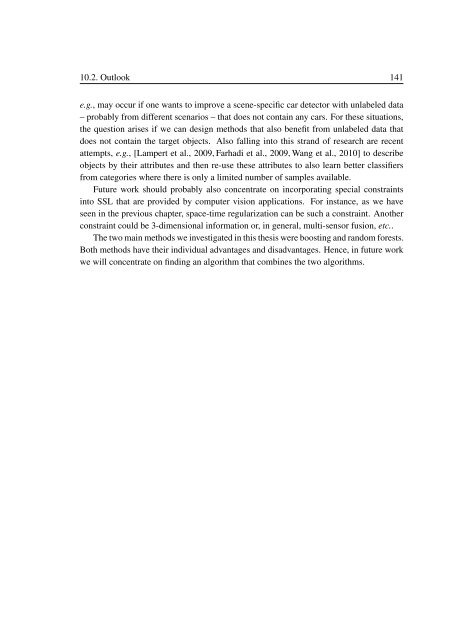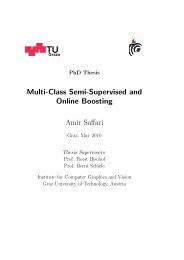PhD Thesis Semi-Supervised Ensemble Methods for Computer Vision
PhD Thesis Semi-Supervised Ensemble Methods for Computer Vision
PhD Thesis Semi-Supervised Ensemble Methods for Computer Vision
Create successful ePaper yourself
Turn your PDF publications into a flip-book with our unique Google optimized e-Paper software.
10.2. Outlook 141<br />
e.g., may occur if one wants to improve a scene-specific car detector with unlabeled data<br />
– probably from different scenarios – that does not contain any cars. For these situations,<br />
the question arises if we can design methods that also benefit from unlabeled data that<br />
does not contain the target objects. Also falling into this strand of research are recent<br />
attempts, e.g., [Lampert et al., 2009, Farhadi et al., 2009, Wang et al., 2010] to describe<br />
objects by their attributes and then re-use these attributes to also learn better classifiers<br />
from categories where there is only a limited number of samples available.<br />
Future work should probably also concentrate on incorporating special constraints<br />
into SSL that are provided by computer vision applications. For instance, as we have<br />
seen in the previous chapter, space-time regularization can be such a constraint. Another<br />
constraint could be 3-dimensional in<strong>for</strong>mation or, in general, multi-sensor fusion, etc..<br />
The two main methods we investigated in this thesis were boosting and random <strong>for</strong>ests.<br />
Both methods have their individual advantages and disadvantages. Hence, in future work<br />
we will concentrate on finding an algorithm that combines the two algorithms.



